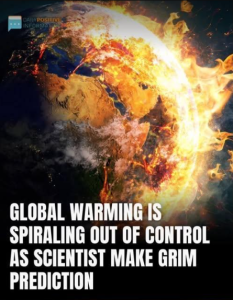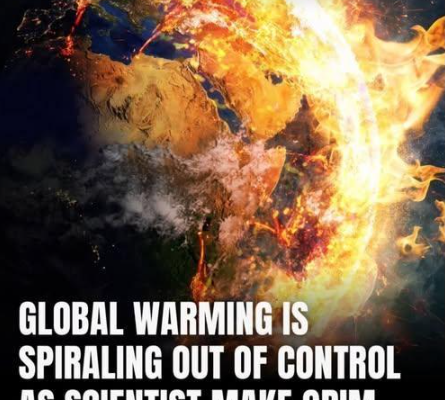Scientists Warn of Extreme Warming Scenarios: Could the Planet Really Heat by 7°C by 2200?
The idea of the Earth’s average temperature climbing by seven degrees Celsius above pre-industrial levels sounds like something from a post-apocalyptic film. Yet, in certain corners of the climate science community, this number occasionally emerges as a long-term possibility, usually tied to worst-case assumptions about greenhouse gas emissions and the potential amplification of warming through feedback loops in the climate system. While the majority of mainstream projections do not foresee such an extreme outcome this century, exploring the idea sheds light on the urgency of the climate challenge and the dangers that lie even in less extreme scenarios.
Where does the 7°C figure come from?
Most widely cited scientific assessments, such as those from the Intergovernmental Panel on Climate Change (IPCC), focus on projections up to the year 2100. Within that time frame, even the highest-emission scenarios top out at roughly 4 to 5°C of warming. A 7°C increase is generally found in extended time horizons that push well beyond the current century, sometimes to the year 2200 or further. It is also sometimes invoked in discussions about “runaway” climate feedbacks—self-reinforcing processes such as permafrost thaw releasing massive amounts of methane, or large-scale dieback of forests reducing the planet’s carbon-absorbing capacity.
Some climate model simulations have explored what could happen if humanity keeps burning fossil fuels at high rates for many decades beyond 2100. In those scenarios, greenhouse gas concentrations would continue to rise, and the planet’s energy imbalance would keep pushing temperatures upward. By 2200, in these theoretical models, global average temperatures could approach or even exceed seven degrees of warming. However, such scenarios are considered low-probability and highly dependent on future human choices.
Why most scientists focus on nearer-term projections
The further out we look, the more uncertainty enters the picture. The climate system is complex, and while the basic physics of greenhouse gases trapping heat is straightforward, the exact interactions between atmosphere, oceans, ice sheets, and living ecosystems over centuries are harder to model. Because of these uncertainties, the IPCC and most national climate assessments emphasize the period up to 2100, where policy decisions today will have the clearest and most direct influence.
That said, even without going to the 7°C extreme, the scientific consensus is clear: the world is on track for dangerous levels of warming this century unless emissions are drastically reduced. Current policies, if left unchanged, are projected to lead to around 2.5 to 3°C of warming by 2100. That amount alone would bring profound changes to weather patterns, sea levels, ecosystems, and human societies.
What a 7°C world might look like
To understand why scientists worry about extreme warming scenarios, it helps to consider the impacts of much smaller increases. At just 1.1°C of warming—the current level—Earth is already experiencing more intense heatwaves, heavier rainfall events, prolonged droughts, and stronger storms. Agricultural yields are being affected, coral reefs are dying, and wildfire seasons are lengthening.
In a world that is seven degrees warmer, these effects would be magnified beyond recognition. Large portions of the tropics could become so hot and humid during parts of the year that simply being outdoors without cooling would be life-threatening. Heatwaves that today might be considered rare once-in-a-century events could occur multiple times each year. Crop failures could become commonplace, leading to chronic global food shortages. Staple crops such as wheat, rice, and maize would struggle to survive outside of controlled environments, and food production would likely shift to higher latitudes, creating immense geopolitical pressure.
Sea level rise would also be far more severe. With this much warming sustained over centuries, the Greenland and West Antarctic ice sheets would likely melt almost completely, contributing many meters of sea level rise. Coastal cities, home to hundreds of millions of people, would be swallowed or forced into costly and constant defensive battles against encroaching seas. Some island nations could disappear entirely beneath the waves.
Ecosystems would face almost unimaginable stress. Many species would be unable to adapt quickly enough to survive such rapid climatic shifts. Forests, grasslands, and wetlands would transform or vanish, disrupting the balance of entire regions. The collapse of biodiversity would ripple through food chains, ultimately affecting human well-being as well.
The human dimension of catastrophic warming
Beyond the physical changes to the environment, a 7°C increase would have deep social and political consequences. Mass migration would likely occur as regions became uninhabitable due to heat, flooding, or resource scarcity. Competition over arable land, fresh water, and food supplies could lead to conflicts both within and between nations. Health systems would be overwhelmed not only by heat-related illnesses, but also by the spread of diseases into new areas as warming reshaped the habitats of insects and other disease carriers.
Economically, the damage would be staggering. Infrastructure not designed for such extremes would fail under new climate pressures. Insurance systems could collapse, investment could dry up in high-risk regions, and the cost of adaptation or recovery would outpace the ability of many countries to respond.
Why even lower warming levels are dangerous
While the 7°C figure grabs attention for its catastrophic implications, scientists emphasize that even much smaller increases are dangerous. At 1.5°C to 2°C of warming—the goals set in the Paris Agreement—the risks of severe impacts grow significantly. Heatwaves become deadlier, coral reefs face near-total destruction, and the risk of crossing tipping points in the climate system increases. For example, the irreversible melting of major ice sheets could be triggered at lower levels of warming than once thought.
This is why climate scientists push for urgent action now. The more we limit warming in the coming decades, the lower the chances of setting in motion processes that would carry us toward extreme scenarios in the far future.
The role of uncertainty
Some might argue that because 7°C by 2200 is speculative, it is not worth worrying about. However, risk management is not only about what is most likely—it is also about what is possible and how severe the consequences would be if it happened. In other fields, such as engineering or public health, rare but catastrophic outcomes are taken seriously, and measures are put in place to guard against them. Climate change, with its potential to disrupt the entire planetary system, warrants a similar level of precaution.
The uncertainties cut both ways. It is possible that technological breakthroughs, societal changes, and policy shifts will keep warming much lower than feared. But it is also possible that the climate system will respond more strongly to greenhouse gases than expected, or that political will to cut emissions will falter. In that case, warming could overshoot current projections and keep rising for centuries.
What we can do now
Avoiding both the likely and extreme scenarios requires decisive action to reduce greenhouse gas emissions. That means transitioning rapidly away from fossil fuels, expanding renewable energy, protecting and restoring forests, changing agricultural practices, and investing in new technologies for carbon removal. It also means adapting to the changes already underway—strengthening infrastructure, preparing health systems, and supporting communities on the frontlines of climate impacts.
International cooperation will be key. Climate change is a global problem, and the atmosphere does not care where emissions come from. Wealthier nations, which have historically contributed the most to greenhouse gas buildup, will need to support lower-income countries both financially and technologically to help them develop sustainably and adapt to climate change.
Conclusion
The possibility of a seven-degree warmer world by 2200 is not the central projection of climate science, but it is a reminder of the long-term stakes. The more we fail to act today, the more we lock in warming for future centuries, and the greater the risk of pushing the planet into dangerous territory. Even if the worst-case scenarios remain uncertain, the path to avoiding them—rapid, sustained cuts in greenhouse gas emissions—is clear. The future climate will be shaped by the choices made now, and while the challenges are enormous, the consequences of inaction are far greater.




